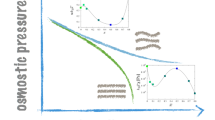Summary
The rate of swelling of egg lecithin liposomes under osmotic shock has been studied employing a stopped-flow spectrophotometer. Incorporation of cholesterol and simple alcohols into the liposomal structure elicits a biphasic response in swelling rate: at low concentrations these additives increase but at high concentrations they decrease water permeabilty. For simplen-alkanols, the effects can be correlated with structure. Specifically, the concentration of alcohol required to elicit maximal permeability as well as the maximal permeability decreases with increasing length of the alcohol. These effects are accounted for on the basis of modification of the orientation and packing of lecithin molecules in the bilayer membrane of the liposome.
Similar content being viewed by others
References
Bangham, A. D., DeGier, J., Greville, J. D. 1967. Osmotic properties and water permeability of phospholipid liquid crystals.Chem. Phys. Lipids 1:225
Bangham, A. D., Standish, M. M., Watkins, J. C. 1965. Diffusion of univalent ions across the lamellae of swollen phospholipids.J. Mol. Biol. 13:238
Bittman, R., Blau, L. 1972. The phospholipid-cholesterol interaction. Kinetics of water permeability in liposomes.Biochemistry 11:4831
Blum, R. M., Forster, R. E. 1970. The water permeability of erythrocytes.Biochim. Biophys. Acta 203:410
Cass, A., Finkelstein, A. 1967. Water permeability of thin lipid membranes.J. Gen. Physiol. 50:1765
Cohen, B. E., Bangham, A. D., 1972. Diffusion of small non-electrolytes across liposome membranes.Nature 236:173
Demel, R. A., Kinsky, S. C., Kinsky, C. B., Van Deenen, L. L. M. 1968. Effects of temperature and cholesterol on the glucose permeability of liposomes prepared with neutral and synthetic lecithins.Biochim. Biophys. Acta 150:655
Forster, R. E. 1971. The transport of water in erythrocytes.Curr. Top. Membranes Transport 2:41
Fourcans, B., Jain, M. K. 1973. Role of phospholipids in transport and enzymic reactions.Advanc. Lipid Res. 11. (In press)
Gutknecht, J., Tosteson, D. C. 1970. Ionic permeability of thin lipid membranes. Effects ofn-alkyl alcohols, polyvalent cations, and a secondary amine.J. Gen. Physiol. 55:359
Hammes, G. G., Schullery, S. E. 1970. Structure of macromolecular aggregates. 2. Construction of model membranes from phospholipids and polypeptides.Biochemistry 9:2555
Hansch, C., Dunn, W. J., III. 1972. Linear relationship between lipophilic character and biological activity of drugs.J. Pharm. Sci. 61:1
Jacobs, M. H., Willis, M. 1947. Preparation and properties of cation permeable erythrocytes.Biol. Bull., Woods Hole 93:223
Jain, M. K. 1972. The Bimolecular Lipid Membrane: A System. Van Nostrand Reinhold Co., New York
Jain, M. K., Cordes, E. H. 1973a. Phospholipases. I. Effect ofn-alkanols on the rate of enzymatic hydrolysis of egg phosphatidylcholine.J. Membrane Biol. 14 (In press)
Jain, M. K., Cordes, E. H. 1973b. Phospholipases. II. Enzymatic hydrolysis of lecithin: Effects of structure, cholesterol content, and sonication.J. Membrane Biol. 14 (In press)
Johnson, S. M., Bangham, A. D. 1969. The action of anesthetics on phospholipid membranes.Biochim. Biophys. Acta 193:92
Ladbrooke, B. D., Williams, R. M., Chapman, D. 1968. Studies on lecithin-cholesterolwater interactions by differential scanning calorimetry and X-ray diffraction.Biochim. Biophys. Acta 150:333
Netsky, M. G., Jacobs, M. H. 1939. Some factors affecting the rate of hemolysis of the mammalian erythrocyte byn-butyl alcohol.Biol. Bull., Woods Hole 77:319
Papahadjopoulos, D., Watkins, J. C. 1967. Phospholipid model membranes. II. Permeability properties of hydrated liquid crystals.Biochim. Biophys. Acta 135:639
Paterson, S. J., Butler, K. W., Huang, P., Labelle, J., Smith, I. C. P., Schneider, H. 1972. The effect of alcohols on lipid bilayers: A spin label study.Biochim. Biophys. Acta 266:597
Ponder, E. 1947. K−Na exchange accompanying the prolytic loss of K from human red cells.J. Gen. Physiol. 32:53
Rendi, R. 1967. Water extrusion in isolated subcellular fractions. VI. Osmotic properties of swollen phospholipid suspensions.Biochim. Biophys. Acta 135:333
Roth, S., Seeman, P. 1971. All lipid-soluble anaesthetics protect red cells.Nature, New Biol. 231:284
Roth, S., Seeman, P. 1972. The membrane concentrations of neutral and positive anesthetics (alcohols, chlorpromazine, morphine) fit the Meyer-Overton rule of anesthesia; Negative narcotics do not.Biochim. Biophys. Acta 255:207
Seeman, P. 1972. The membrane actions of anesthetics and tranquilizers.Pharmacol. Rev. 24:583
Seeman, P., Roth, S., Schneider, H. 1971. The membrane concentrations of alcohol anesthetics.Biochim. Biophys. Acta 225:171
Seeman, P., Sha'afi, R. I., Galey, W. R., Solomon, A. K. 1970. The effect of anesthetics (chlorpromazine, ethanol) on erythrocyte permeability to water.Biochim. Biophys. Acta 211:365
Sessa, G., Weissmann, G. 1968. Phospholipid spherules (liposomes) as a model for biological membranes.J. Lipid. Res. 9:310
Sha'afi, R. I., Rich, G. T., Mikulecky, D. C., Solomon, A. K. 1970. Determination of urea permeability in red cells by minimum method. A test of the phenomenological equations.J. Gen. Physiol. 55:427
Sha'afi, R. I., Rich, G. T., Sidel, V. W., Bossert, W., Solomon, A. K. 1967. The effect of the unstirred layer on human red cell water permeability.J. Gen. Physiol. 50:1377
Singleton, W. S., Gray, M. S., Brown, M. L., White, J. L. 1965. Chromatographically homogeneous lecithin from egg phospholipids.J. Amer. Oil Chem. Soc. 42:53
Skou, J. C. 1958. Relation between the ability of various compounds to block nervous conduction and their penetration into a monomolecular layer of nerve-tissue lipoids.Biochim. Biophys. Acta 30:625
Van Deenen, L. L. M. 1971. Chemistry of phospholipids in relation to biological membranes.Rev. Pure Appl. Chem. 25:25
Vanderkooi, J. M., Martonosi, A. 1971. Sarcoplasmic reticulum. XVI. The permeability of phosphatidylcholine vesicles for calcium.Arch. Biochem. Biophys. 147:632
Author information
Authors and Affiliations
Rights and permissions
About this article
Cite this article
Jain, M.K., Touissaint, D.G. & Cordes, E.H. Kinetics of water penetration into unsonicated liposomes effects ofn-alkanols and cholesterol. J. Membrain Biol. 14, 1–16 (1973). https://doi.org/10.1007/BF01868065
Received:
Issue Date:
DOI: https://doi.org/10.1007/BF01868065



